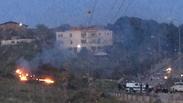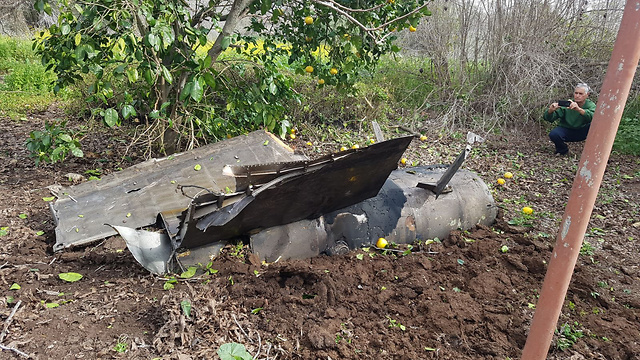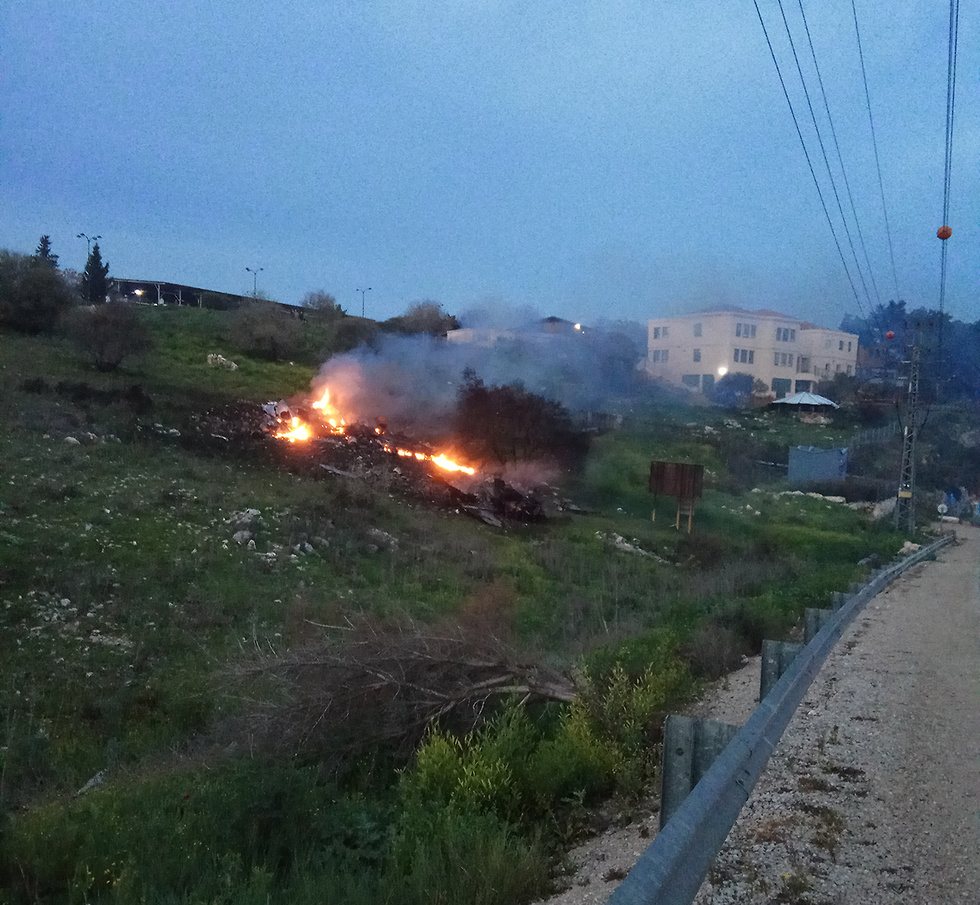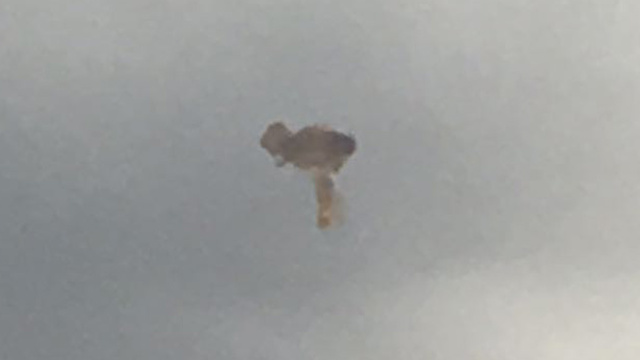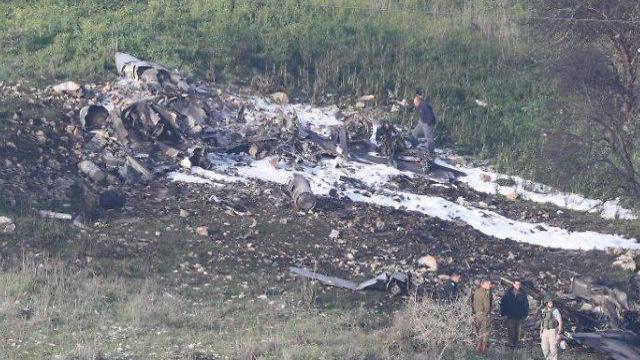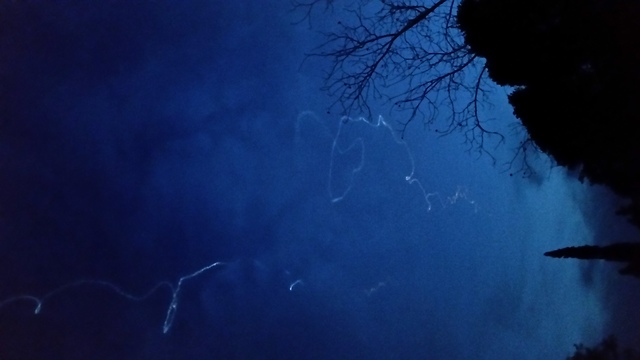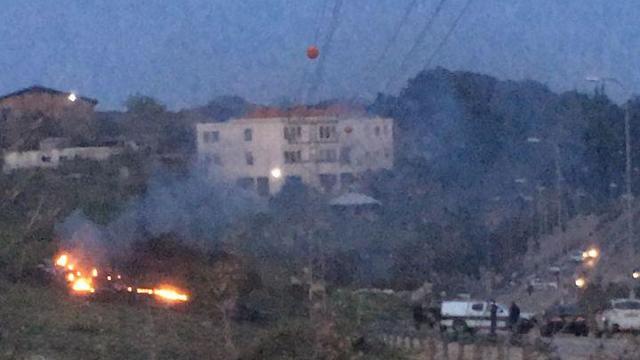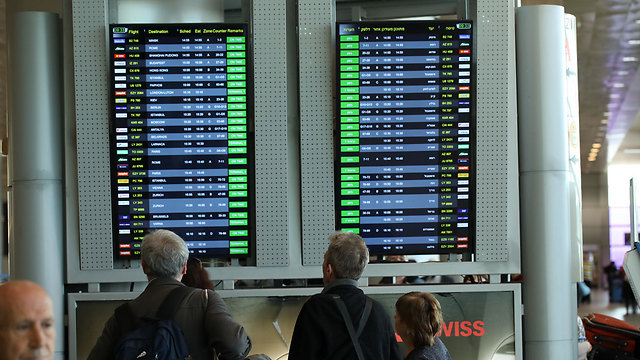
Two IAF pilots hurt after F-16 downed during retaliatory strike in Syria
Apache helicopter downs Iranian drone that entered Israel, triggering alarms in Beit She'an region; IDF attacks Iranian targets in Syria in retaliation; Syria fires antiaircraft missiles at Israeli F-16s, leading pilots to bail out; IDF: 'Incident is ongoing. Iran dragging the entire region to an adventure and will pay the price.'
Two Israeli F-16 pilots were hurt Saturday morning after their plane was shot down and crashed in Israel following a retaliatory strike in Syria.
The pilots were able to bail out of the plane. One pilot was seriously wounded, while the other was only lightly hurt. They were taken to the Rambam Medical Center in Haifa for treatment.
The IDF's strike was in response to an earlier infiltration into Israel of an Iranian drone originating from an airfield near Palmyra, Syria, which was successfully intercepted by an IDF Apache helicopter.
The Iranian drone is considered to be very advanced and spent about a minute and a half in Israeli territory after crossing the Israel-Jordan border.
"We'll study this UAV. This is the first time an Iranian drone has crossed into Israel and it is in our hands," said IAF Chief of Staff Brig. Gen. Tomer Bar, adding the army will take advantage of the opportunity to study the UAV.
Bar said the drone was shot down without imposing any risk to civilians. He added the ary is not yet sure whether it was intended for surveillance and intelligence gathering or for an orchestrated attack on Israeli civilians.
According to the IDF Spokesperson's Unit, during the attack on the site from which the drone was launched, carried out by eight Israeli fighter jets, the Syrian army retaliated with widespread antiaircraft fire. Pilots of one of the fighter jets recognized antiaircraft missiles locking onto their plane, prompting them to eject.
The fighter jet crashed in an open area near Kibbutz Harduf. The police said the crash caused no casualties or damage in the community.
Alarms sounded across northern and central Israel during the attack as a result of the antiaircraft fire, with several such missiles and their components landing in open territory.
Syrian television, meanwhile, quoted a military source in saying that, "Israel carried out new aggression early morning against one of the army bases in the country's center, and our air defense mechanisms resisted and hit more than one plane." The IDF rejected the report, saying only one plane was hit.
12 targets hit
The IDF said it launched a large scale attack against Syrian aerial defense systems and Iranian targets in Syria.
"Twelve targets, including three aerial defense batteries and four Iranian targets that are part of Iran's military establishment in Syria were attacked," the military said in a statement.
"During the attack, anti-aircraft missiles were fired towards Israel, triggering alarms that were heard in northern Israel," the military said.
The military added it was "ready for various scenarios and will continue to act according to situation assessments."
Syrian SA5 and SA17 missile batteries were targeted, the IDF said, adding that the Iranian targets to be hit were in the vicinity of the Syrian 4th Division.
Syrian media outlets reported that one of the sites targeted by the Israeli air force was an Iranian military base within the greater T-4 Syrian army base complex in the eastern Homs province, 60km east of Palmyra—the same airfield from which the drone took off towards Israel.
Militias affiliated with the regime of Syrian President Bashar Assad confirmed the Israeli strike against the drone launching station at the T-4 base, which they claimed was used to collect intelligence on terrorist groups in Syria, including the Islamic State.
"Israel's claims that the drone infiltrated its territory are false," the militias' comment elaborated. "Israel's terrorist activities will no longer be passively accepted, with each new Zionist attack earning a serious response."
Al-Jazeera reported that as a result of the attack, air traffic at the T-4 base was shut down completely and that the airfield's control center was damaged, adding later that IDF "military implements" were directed to the Golan Heights.
Arab media further reported that besides targets in the T-4 airbase, Israel also attacked a military base in the a-Dimas region west of Damascus and near the Lebanese border, the Mezzeh Military Airport in southwestern Damascus, a base of the 104 Division of the Syrian Republican Guard, and a regime weapon storage facility south of al-Kaswa, which is south of Damascus.
A Syria war monitor said Israel struck targets in central Syria and the southwestern suburbs of the capital Damascus in two separate and successive waves of airstrikes.
The Syrian Observatory for Human Rights says the first round targeted in the central desert area where Syrian troops and their Iranian-backed allies including Hezbollah are known to maintain bases. It cited unconfirmed reports of casualties among Syrian government forces and allied militiamen.
The Britain-based Observatory, which monitors the Syria war through a network of activists on the ground, says the second round targeted outposts in the southwestern suburbs of Damascus.
A Syrian military official responded to the attack in an interview with Lebanese new site A-Nashra, saying, "The country's air defense system will continue to engage any Israeli attempt to harm Syrian land."
"The system have already hit several missiles and an Israeli aircraft carrying out attack south of the capital of Damascus, west of the capital and on the outskirts of Homs," the military source added.
"The damage caused by this aggression," the source concluded, "was limited to property and several soldiers being wounded."
An official Lebanese official told Sky News Saturday afternoon that the Lebanese army elevated its readiness to its highest level in the wake of the Israeli confrontation with Syria and Iran.
'Syrians and Iranians are playing with fire'
Providing further comment, the IDF Spokesperson's Unit said that, "Israel has been carrying out a clear defensive action in the past few hours against subversive Iranian actions against Israel.
"The decision, navigation and all of the drone's components were Iranian. Its interception took place precisely where we desired and with immense success. The Syrians and Iranians are playing with fire."
"The incident was in total (Israeli) control at every stage of the way," the army added. "The results of our attack are not yet fully known to them, and they may be surprised when they discover what we targeted."
Defense Minister Avigdor Lieberman convened with top defense establishment brass—including Chief of Staff Gadi Eisenkot—at military headquarters in Tel Aviv to discuss a further response.
Lieberman, along with Prime Minister Benjamin Netanyahu, will be holding another situation assessment with the participation of both Eisenkot and other senior army and defense establishment officials.
Alarms blaring in northern Israel
Saturday's events began when an alarm sounded at 4:25am in Beit She'an and the Gilboa and Emek HaMa'ayanot Regional Councils.
The IDF initially said the alarm was not triggered by fire directed at Israel, and later released a statement elaborating on the events that transpired.
"The IDF successfully intercepted an Iranian drone launched from Syria that infiltrated Israeli territory," the message said. "The unmanned aircraft was picked up by air defense systems at an early stage and was under surveillance until it was downed.
"In retaliation, the IDF attacked Iranian targets in Syria. Alarms sounding in the Golan Heights were a result of Syrian antiaircraft fire. The incident is still ongoing. The IDF will continue to operate against any attempt to infiltrate Israeli airspace and will act with grave measures to prevent the violation of Israeli sovereignty."
The army's announcement further said that, "The Iranian drone was downed in Israeli territory and is in our possession. As a result, its capture triggered alarms in the region. We have attacked the Iranian trailer from which the drone was launched. The assault was complex and surgical. The target was destroyed.
"In the course of the incident, pilots of an F-16 initiated an ejection protocol from their plane, which was downed in the Beit Netofa Valley region. The pilots are in IDF hands, and in good physical condition. The reason for the ejection is as yet unclear. In addition, a Syrian antiaircraft missile landed in the Golan Heights."
Residents reported increased IAF aerial traffic in the Beit She'an Valley region and near the Jordanian border starting around 4am. Further alarms blared in the Golan Heights later, and sounds of the aerial activity were audible in northern and even central Israel.
Residents of one of the northern kibbutzim said they heard a distant explosion before an alarm sounded, and added they saw a helicopter flying over the Jordanian border. Some of the kibbutzim, however, received notification that the alarms were caused by a malfunction.
Alarms sounded again at 5:45am—this time in the Golan Heights and, highly irregularly so, in the northern Jordan Valley. Residents of said regions also reported hearing explosions and elevated aerial activity.
Many communities in the north unlocked their bomb shelters as a precautionary measure, which was an independent initiative and not due to IDF instructions.
After initially receiving instruction to remain in shelters by the communities' own administrations rather than the IDF, the Golan Heights Regional Council's operational headquarters allowed residents to leave shelters and instructed them to remain alert.
Chief of Staff Eisenkot concluded a situation assessment at 7am with the air force. The IDF Spokesperson's Unit added, "Iran is dragging the entire region into an adventure whose end is shrouded in darkness. It was a grievous violation of Israeli sovereignty by Iran. Anyone involved in the drone's launch was targeted."
A series of alarms once again sounded just before nine in the morning in communities in the Jordan Valley and Upper Galilee. They were followed by another series of alarms 15 minutes later in the Upper and Western Galilee as well as the Golan Heights, but again no rockets were reported to have fallen inside Israel.
Due to the events in the north, landings at Ben Gurion Airport were suspended for about 15 minutes and take-offs were held for about 20 minutes Saturday morning, in accordance with a status evaluation with security officials. The airport has since resumed normal operations.
In addition, Israeli airspace north of the Shefayim kibbutz was closed off to civilian flights due to air force activities, as jets were using the route to reach the northern frontier.
Ynet commentator Ron Ben Yishai noted that the Syrian had threatened two weeks ago to target Israel's largest airport in retaliation to an attack attributed to Israel.
Heightened tensions
The last time an alarm sounded near the Jordanian border was in March of last year, when Syrian antiaircraft missiles were launched at IAF planes attacking in Syria. The missiles were intercepted by Israeli Arrow 2 missiles.
Thursday evening an IDF Skylark drone collecting intelligence faced machine-gun fire from Syrian positions in the northern Golan Heights. The same evening several errant bullets hit a home in Majdal Shams, situated in the same region. No casualties were reported but the domicile was damaged.
Israel attacked Syrian targets numerous times over the past few years—according to foreign sources—hitting installations and advanced weapons convoys headed for Hezbollah, usually with Iranian financing.
Tensions in the northern sector have been elevated over the past few weeks, especially following the unusual Israeli warning regarding retaliating to Iranian attempts to procure precision-targeted missiles in Lebanon.
Israel has long complained about the involvement of archenemy Iran, and Iranian proxy Hezbollah, in the Syria war. The Shiite allies have sent forces to back Syrian President Assad, who appears headed toward victory after years of fighting. Israel has said it will not accept a permanent military presence by Iran and its Shiite allies in Syria, especially near the Israeli border.
Israel has been warning of late of the increased Iranian involvement along its border in Syria and Lebanon. It fears Iran could use Syrian territory to stage attacks or create a land corridor from Iran to Lebanon that could allow it to transfer weapons more easily to Hezbollah.
Israel has shot down several drones that previously tried to infiltrate its territory from Syria. The targeting of an Iranian site in response, however, marks an escalation in the Israeli retaliation.
Yoav Zitun, Ahiya Raved, Liad Osmo, Hassan Shaalan, Itamar Eichner, Itay Blumenthal, Reuters and The Associated Press contributed to this report.
